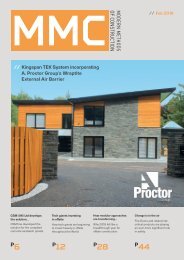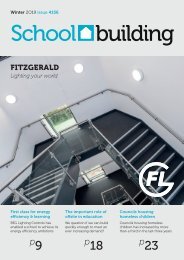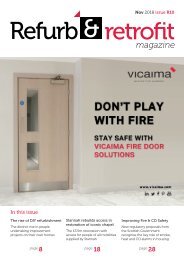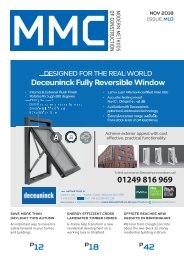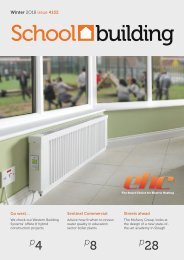R1 R&R Sept '16 52 cc
You also want an ePaper? Increase the reach of your titles
YUMPU automatically turns print PDFs into web optimized ePapers that Google loves.
Fire Protection, Safety & Security<br />
No Compromise on Safety<br />
Rex Taylor, Technical Support Manager of Kidde Safety, calls for better provision of smoke and carbon monoxide alarms with<br />
housing refurbishment.<br />
Without doubt, smoke and heat<br />
alarms save lives and housing<br />
refurbishments offer an ideal<br />
opportunity to update them. Definitive<br />
guidance can be found in BS 5839, Part 6,<br />
which lists the minimum ‘Categories’<br />
(locations for the alarms) and ‘Grades’ (types<br />
of power source in the alarms)<br />
recommended for different types of housing,<br />
including owner-o<strong>cc</strong>upied and rented.<br />
Heat Alarms in all Kitchens<br />
For most homes up to 3 storeys, the Code<br />
recommends ‘Category LD2’. This means<br />
smoke alarms in any areas where fires might<br />
start, such as living rooms, as well as escape<br />
routes, plus heat alarms in every kitchen. With<br />
converted properties and new-builds, national<br />
Building Regulations apply and those for<br />
Scotland and Northern Ireland mirror the<br />
Code.<br />
But in England and Wales, Approved<br />
Document B falls short, requiring only<br />
Category LD3 with smoke alarms just in<br />
escape routes and heat alarms only in kitchens<br />
open to escape routes. Yet, as the Code<br />
stresses, with Category LD3 the evacuation<br />
time once fire is detected in the escape route<br />
“might not prevent death or serious injury of<br />
o<strong>cc</strong>upants of the room where fire originates”.<br />
Building Regulations and the Code are all<br />
agreed in demanding Grade D mains with<br />
back-up, interconnected smoke and heat<br />
alarms for all new and most existing homes.<br />
These should always be interconnected so<br />
that all the alarms sound when one is<br />
triggered. But there are often reasons to avoid<br />
interconnect cabling in existing buildings.<br />
Here, wireless interconnection is an ideal<br />
solution, with each alarm simply powered<br />
from a lighting circuit nearby. Some wireless<br />
ranges also offer additional facilities, for<br />
example a remote switch to control an alarm<br />
that might otherwise be difficult to a<strong>cc</strong>ess.<br />
This is particularly useful for elderly or disabled<br />
people, or where alarms are fitted on higher<br />
ceilings.<br />
Curbing CO Poisoning<br />
There is also a strong case to fit carbon<br />
monoxide alarms in all homes. The latest<br />
guidance is provided by BS EN 50292:2013. It<br />
recommends that, ideally, a CO alarm should<br />
be installed in every room containing a fuelburning<br />
appliance and also in other well-used<br />
rooms remote from the appliance, as well as<br />
all bedrooms. In addition, rooms with<br />
extended or concealed flues passing through<br />
should also have an alarm.<br />
Building Regulations throughout the UK all<br />
require CO alarms to varying degrees but only<br />
with installation of new or replacement<br />
combustion appliances – and that excludes<br />
those used for cooking. In particular, BS EN<br />
50292’s more rigorous approach contrasts<br />
starkly with Approved Document J for England<br />
and Wales. This only demands a CO alarm<br />
with installation of certain, solid fuel heating<br />
appliances. The continuing toll of deaths and<br />
illness associated with other fuels and types of<br />
combustion appliances – including cookers –<br />
highlights the need to raise the bar with<br />
carbon monoxide.<br />
For more information, email<br />
sales@kiddesafety.co.uk,<br />
call 01753 766 392 or visit<br />
www.kiddesafetyeurope.co.uk<br />
30 Refurb retrofit<br />
magazine<br />
Sep/Oct 2016 <strong>R1</strong>





